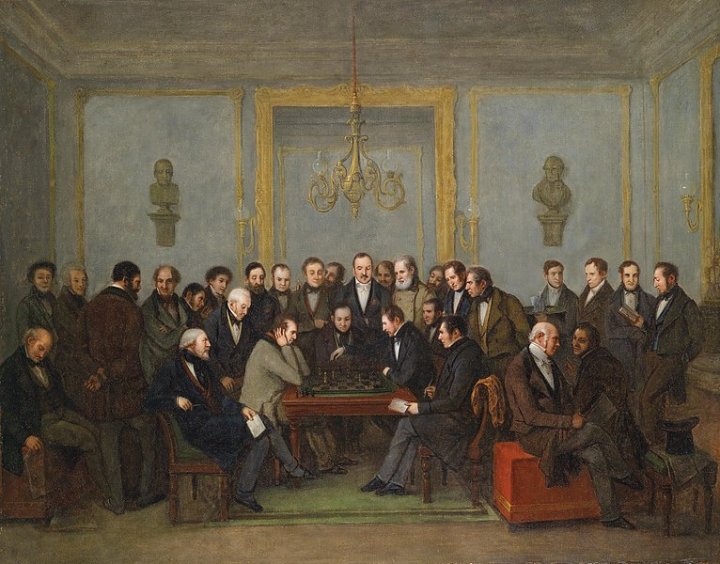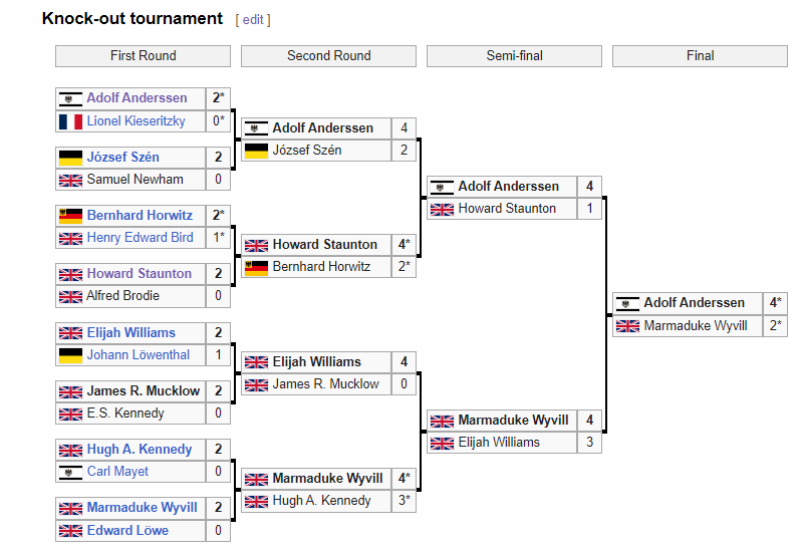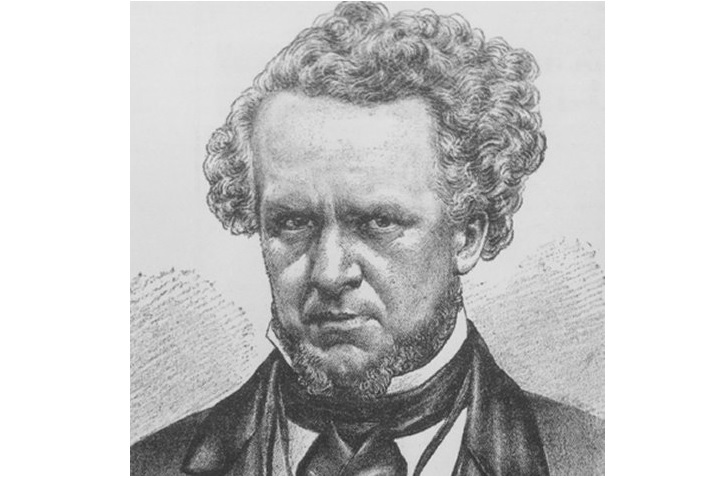Did Staunton advance chess, or did he only divide the English and international chess community? On the 172nd anniversary of the first international tournament he arranged, The London Tournament of 1851 (May 26 - July 12, 1851), it is fitting to remember his life and career.
Not much is known about the early life of Staunton. He claimed to have been born in Keswick, Cumberland, England, and listed William Staunton as his father. His mother is not known. Records of his birth or baptism have not been found.
According to the historian H.J.R. Murray, Staunton was born sometime in April 1810. Speculation went that he was the illegitimate son of Frederick Howard (thus, his first name Howard), fifth Earl of Carlisle. He attended Oxford University but likely did not graduate. It is not certain whether he learned chess early, or learned it in his short stay in the university, but it is settled that he came to London in 1836 raring to succeed in the game.
Staunton was about 26 when he came to London, and by his admission he was a rook player. This meant that in handicap games that were then popular in the Victorian era, top players could easily give him the odds of a rook. Such strong players of the time were Pierre St. Amant of France, and George Walker and William Lewis of England.
Staunton progressed rapidly in London, and in 1838 he beat the veteran professional Aaron Alexander in a match over 21 games. In these early years, Captain William Evans, the inventor of the Evan’s Gambit, and the strong barrister, John Cochrane, happened to be frequent opponents. In 1840, he won his first serious match against William Popert, a German merchant resident in London, 13-12.
Staunton improved by playing handicapped games. By 1840, he was acknowledged as a brilliant player, and hardly anyone could withstand him without himself conceding odds.
As Staunton rose, his writing career began. Beginning May 1840, he ran a column for the New Court Gazette, which unfortunately ended in December of that year. More successful was his engagement with the British Miscellany, which in 1841 became the Chess Player's Chronicle, England's first successful chess magazine. Soon after, he was also invited to edit the chess section of the British Almanac.
In 1843, Staunton decisively defeated Cochrane, 14-4, and by consensus became England's strongest player. Early that year, St. Amant visited London on a business trip, and a short match was arranged between him and Staunton for a small stake.
France, with its outstanding chess culture and tradition, had produced Europe's last two dominant players, Alexandre Deschapelles and Louie Maje de la Bourdonnais. St. Amant was regarded as their successor, although his results and reputation were neither as impressive nor as high. He had defeated England's strongest players in his annual trips to London, and beat Staunton himself, 3-2, with 1 draw.
Both men disputed whether St. Amant's victory had earned him recognition as the world's best player. St. Amant believed he and his opponent took the match seriously, but Staunton didn't think a short match with only one guinea at stake could be anything significant. They agreed, however, that a match that close called for a new one, this time with the terms clearer, and the stakes greater.
The match was set in November 1843 at the Paris Chess Club, with Staunton and St. Amant playing a race to eleven for 100 sterling aside. Staunton began explosively, winning seven of the first eight games, conceding only a draw. Staunton led 10-3 after fifteen games, but St. Amant rallied with three wins. Staunton averted a collapse and scored his final victory to take the match, 11-6.

Staunton vs St. Amant | Picture source: Twitter account "Howard Staunton"
Staunton's triumph put an end to the French dominance that started with Andre Danican Philidor in the 18th century. London, thereafter, became Europe's chess capital.
Staunton carried on with his endeavors as a chess professional up to the end of the 1840s. In 1845, he became a columnist of the Illustrated London News, which turned out to be the most significant writing engagement of his life. He promoted chess passionately. Through his columns he presented his analysis of the latest significant games and corresponded with the public up to his death in 1874.
In 1846, Staunton scored fully convincing victories over two of the strongest foreign players residing in England at that time. He beat Bernhard Horwitz comfortably, 15.5-8.5.
.jpg)
Staunton vs. Horwitz | Picture source: Wikipedia
The other match, against Daniel Harrwitz, was very unusual. Staunton emerged victorious in two out of the three matches, with each match consisting of seven games. One was played even and the other two at varying odds. The match on even terms, particularly, was a rout, 7-0. Harrwitz certainly was not the virtuoso that Staunton was, especially in handicapped games, and he was only developing into a formidable player. Yet, the results proved undoubtedly that Staunton was far stronger than his peers.
In 1847, Staunton produced his best-selling Chess Player's Handbook, which for many generations became the basic text of English-speaking players. It gained him recognition as the foremost authority on chess openings. It so impressed Robert James Fischer that he described Staunton as "the most profound opening analyst of all time." In 1849, Staunton released The Chess Player's Companion, which contained a large collection of his games.
In 1849, Staunton promoted a chess set designed by Nathaniel Cooke and manufactured by Jaques of London, which anticipated product endorsement by famous athletes. He wrote a little volume, The Chess Player's Text Book, included free for each set. The set, with its highly distinguishable and stable pieces, caught on with the public, and the rest became history.
.jpg)
The original Staunton pieces | Photo: Wikipedia
In 1851, London staged the Great Exhibition, which showcased British industry and technology. The thriving London chess community, thinking that the exhibition would boost transportation and ease travel restrictions, endeavored to host the first ever international tournament.
Stanton took the lead in organizing the event. Apart from gathering Europe's best players, he planned a chess parliament where he hoped contentious issues of the day were to be settled. These included, among others, the standardization of chess notation and the setting of time limits, as many players were known to "out-sit" their opponents. Staunton also proposed to produce a compendium of the known openings at the tournament's conclusion.
Staunton worked hard to meet the event's organizational and financial challenges. He raised £500 for the prize fund, a considerable sum in 1851. Subscriptions were obtained from chess clubs in England and overseas. From France, collections were made at the Café de la Regence, and from India, the Calcutta Chess Club contributed £100. In addition, Cochrane and T.C. Morton, principal officers of the St. George Club, made two of the four largest personal contributions.
The tournament was planned as a knock-out contest involving sixteen of Europe's best players. Foreign masters invited from Hungary, Germany, France, and Russia included Vincent Grimm, József Szén, Johann Löwenthal, Adolf Anderssen, Horwitz, Carl Mayet, Von der Lasa, Saint-Amant, Lionel Kieseritzky, Carl Jaenisch, Alexander Petrov, and Ilya Shumov. The British players were to be Staunton, Henry Thomas Buckle, Marmaduke Wyvill, Elijah Williams, Captain Hugh Alexander Kennedy, Samuel Newham, and Henry Bird.
The tournament was only moderately successful, as many of the invited participants were unable to play. Grimm was exiled in Aleppo after his participation in the failed Hungarian Revolt. Saint-Amant was unavailable as he had been sent by the French government to California as a diplomat following its independence from Mexico. Von der Lasa and Petrov also failed to attend. Jaenisch and Shumov arrived late. An ongoing feud between the St. George Club and the London Chess Club prevented Daniel Harrwitz from playing. Anderssen almost did not play as he was deterred by the travel costs, and Staunton was forced to bear Anderssen’s expenses personally.
No form of seeding was employed, moreover, and the pairings were made by chance. As a result, three of the stronger players, Kieseritzky, Bird, and Lowenthal all lost in the first round.
Staunton beat the undistinguished M. Brodie in the first round, and then Horwitz in the mini-match of first to win four games in the second round. In the third round, he fell to the German, Anderssen, 4-1, who went on to win the event, beating Marmaduke Wyvill in the finals.

Match results of London 1851
Whatever its shortcomings, London 1851 was undoubtedly a watershed event that paved the way for more international events. Anderssen, too, was a deserving winner, and he dislodged Staunton as the world's leading player.
After an aborted friendly match with Von der Lasa and a failed attempt to arrange a new match with Harrwitz in 1853, Staunton gradually withdrew from chess. He focused on Shakespearean scholarship, his other great endeavor. On April 28, 1856, he signed a contract with Routledge and Company to prepare an edition of Shakespeare's dramatic works. Still, Staunton remained highly influential in chess. He retained his column in the London Illustrated News, which was read worldwide and gave him far more readers than any other editor.
Paul Morphy swept through Europe in 1858, and much has been said about the futile match negotiations between him and Staunton. Staunton may have reckoned that he stood no chance against the American juggernaut, and was unwilling to play all along. Quite possibly, however, Staunton's literary commitments may have really prevented him from preparing himself thoroughly. In 1858, he was obliged to submit installments of his work to Routledge and Company, with their contract imposing penalties if Staunton defaulted. Rather than prepare himself haphazardly and risk his reputation in such a testing match, Staunton was likely avoiding it prudently. The matter, perhaps, will never be settled.
For all his brilliance and worth to the chess world, Staunton was a prideful man who slighted more than a few colleagues at the peak of his playing and writing career. He was given to boasting, belittling opponents, and discrediting those who were a threat to his sporting, journalistic, and literary standing. He had ready excuses for his losses, kept the public from knowing match losses, and concealed games from these lost matches. Indeed, he was not a very admirable character.
In the first match against St. Amant, for instance, Staunton warned readers of the Chessplayer's Chronicle that all six games were "of inferior quality, affording nothing like a test of the relative skill of the two players." He mentions also that he should have won the second and fifth games easily. "The timidity so foreign to Mr. S's usual style of play, which he exhibits in this contest, is undoubtedly attributable to the state of his health," he added. In his annotations of the games in their rematch, he was always magnanimous in victory but full of excuses in defeat.
Even Horwitz, who was described by his peers as a simple, kind-hearted man, was not spared from Staunton’s imprudence. After defeating Horwitz in 1846, Staunton wrote that he might have declined the challenge from "a comparatively unknown competitor, unless for a large stake." He then hinted that the score would have been more lopsided than 15.5-8.5 if he had been given more incentive. He treated other top players just as shabbily, and was particularly ungracious to the victorious Anderssen in his tournament book of London 1851.
Staunton strained his relationship with his colleagues, and nowhere did this become more evident than in London 1851. As he was organizing the event, players of the London Chess Club, led by Walker, attempted to steal his thunder by arranging a separate tournament. Fortunately for Staunton, the event floundered. Players withdrew when it became obvious that they could not finish among the prize winners. Anderssen, in any case, also won the tournament. Staunton had his own supporters, and he had quite evidently driven a wedge among the English and foreign resident masters of England.
Staunton was tall and broad-shouldered, and he wore whiskers that gave him a leonine head. He dressed elegantly, and was said to "walk like a king among his fellows." His contemporary, George Alcock Macdonnell, described him "… wearing a lavender zephyr outside his frock coat. His appearance was slightly gaudy, his vest being an embroidered satin, and his scarf gold-sprigged with a double pin thrust in, the heads of which were connected by a glittering chain."
.jpg)
Full body sketch of Howard Staunton | Picture source: British Chess News
Staunton was working on his Illustrated column when he passed away by heart failure on June 22, 1874.
The chess world’s reaction to Staunton’s death was understandably mixed. The strong journalist, John Wisker, gave a measured but predominantly negative assessment:
"His influence on the progress of the game will ever remain a disputed question. The old maxim nils de mortuis (of the dead nothing but good is to be said) cannot be carried beyond a certain point; and it is indisputable that a large section of the British players consider that the faction fights carried on under the banner of Mr. Staunton caused so much harm as to counterbalance the good he did by his play and writings."
William Norwood Potter was more severe. In his City of London column he wrote:
"His harsh attacks against Anderssen, Williams, Harrwitz, Lowenthal, and Steinitz must ever be considered a harsh misuse of his vigorous intellect, especially as they were often conducted in a manner not at all consistent with a truthful spirit."
But even Potter could not hide the admiration which he, and even Staunton’s foes, had for him. "There was nothing weak about him," he said, "and he had a backbone that was never curved with fear of anyone."
The writer and historian, Philipp Walsingham Sergeant, gave a fairer assessment. He wrote:
"Against Staunton’s obvious defects of character must be set the eminent gifts which establish his place in chess history; the mental grasp that enabled him to formulate the theory of positional-play before the advent of Steinitz; and a vision far ahead of his times. By the exercise of these gifts he put posterity heavily in his debt."
Reminiscing in 1897, Charles Edward Ranken gave perhaps the most fitting and truthful estimation of the paradox that was Howard Staunton. "With great defects he had great virtues," he said. "There was nothing mean, cringing, or small in his nature, and, taking all in all, England never had a more worthy chess representative than Howard Staunton."
References:
Harding, Tim. Eminent Victorian Chess Players: Ten Biographies. North Carolina: McFarland &
Company, Inc., Publishers, 2012.
Hartston, William. The Kings of Chess. New York: Harper & Row, Publishers, 1985.
Upham, John. (2020, June 22). Remembering Howard Staunton (??-IV-1810 22-VI-1874).
https://britishchessnews.com/2020/06/22/remembering-howard-staunton-01-iv-1810-22-vi-1874/
www.ruchess.ru. (2023, April 1). Howard Staunton.
https://ruchess.ru/en/persons_of_day/howard_staunton/
Wikipedia. 2023. "Howard Staunton." Last modified June 28, 2023.
https://en.wikipedia.org/wiki/Howard_Staunton
Wikipedia. 2023. "London 1851 Chess Tournament." Last modified May 14, 2023.
https://en.wikipedia.org/wiki/London_1851_chess_tournament
Games
As a modern, positional player, Staunton came before Steinitz. He played slowly and employed deep strategy when tactics and swift attacks were popular during the Romantic Age. If his legacy has been little understood, it was because he was very far ahead of his time. Here are three Staunton games that feel thoroughly modern, and two others that are tactically brilliant.
Staunton vs. Williams, 8th match game, London 1851 – A strategic masterpiece played in a private match after the London 1851 tournament. Staunton applies the principle of control instead of occupation of the center seventy years before the Hypermodern movement.
Staunton vs. Horwitz, London 1851 – Staunton plays a positional squeeze in his best game of the London 1851 tournament.
Saint Amant – Staunton, Game 5 1843 Match (Paris) – A superbly played closed game out of a French Defense by transposition.
Staunton vs. Cochrane, London 1842 - As strong a positional player as he was, Staunton could also play in the sacrificial, Romantic spirit.
Cochrane vs. Staunton, London 1842 - Staunton lights some tactical fireworks in this game.
Links
More articles by Eugene Manlapao...



















.jpg)
.jpg)

.jpg)





